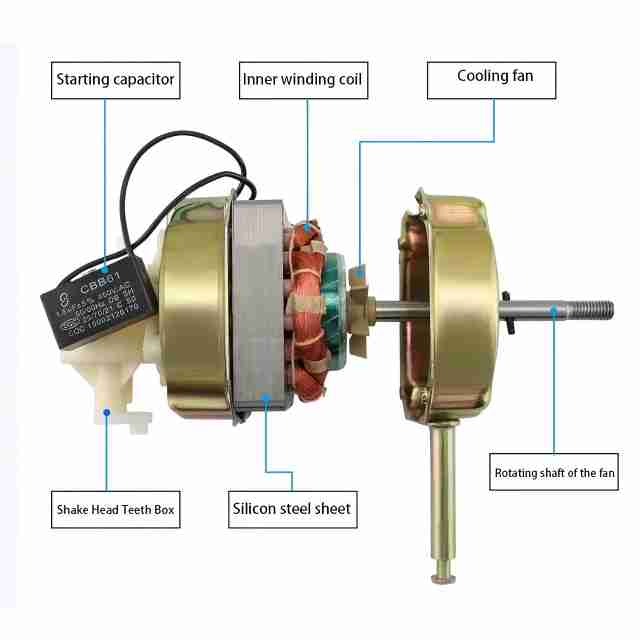Elektrikli Fan Motorunun İnceliklerini Keşfetmek: Understanding the Parts and Function
Giriş
In our daily lives, Exploring the Intricacies of Electric Fan Motor play a crucial role in keeping us cool and comfortable. Whether it’s a hot summer day or a stuffy indoor environment, these simple yet effective appliances are a staple in homes, offices, and various commercial spaces. At the heart of every electric fan lies the electric fan motor, an engineering marvel that converts electrical energy into mechanical energy to create the refreshing breeze we enjoy. Understanding the inner workings of an electric fan motor is not only fascinating but also practical. It can help us troubleshoot common issues, make informed decisions when purchasing a new fan, and even perform basic maintenance to extend the lifespan of our fans. In this article, we will delve deep into the world of electric fan motors, exploring their parts and functions in detail.
Understanding the Anatomy of an Electric Fan Motor
Stator and Rotor: The Core Components
The stator and rotor are the fundamental parts of an electric fan motor. The stator is the stationary part of the motor, Exploring the Intricacies of Electric Fan Motor typically made up of a set of coils wound around a laminated iron core. These coils are designed to create a magnetic field when an electric current passes through them. The rotor, on the other hand, is the rotating part. It consists of a shaft with a series of conductive bars or coils arranged in a circular pattern. When the magnetic field generated by the stator interacts with the rotor, it causes the rotor to rotate. This rotational motion is what ultimately drives the fan blades to move and create air circulation.
Bearings: The Critical Support System
Bearings are an essential component in an electric fan motor. Exploring the Intricacies of Electric Fan Motor They provide support to the rotor, allowing it to rotate smoothly with minimal friction. There are different types of bearings used in electric fan motors, such as ball bearings and sleeve bearings. Ball bearings use small metal balls between two races to reduce friction, while sleeve bearings rely on a thin film of lubricant between a shaft and a sleeve. Good quality bearings are crucial for the efficient operation of the motor. Exploring the Intricacies of Electric Fan Motor They help to reduce wear and tear on the rotor shaft and ensure that the motor runs quietly and smoothly.
Capacitor: Providing the Necessary Boost
The capacitor is another important part of an electric fan motor. In single – phase motors, which are commonly used in household fans, a capacitor is required to start the motor. When the power is turned on, the capacitor provides an initial electrical boost to create a phase difference between the main winding and the auxiliary winding in the stator. Exploring the Intricacies of Electric Fan Motor This phase difference generates a rotating magnetic field that starts the rotor spinning. Once the motor is running, the capacitor may also play a role in maintaining the motor’s speed and efficiency. There are different types of capacitors used in electric fan motors, such as start capacitors and run capacitors, each with its specific function.
Wiring System: Connecting it all Together
The wiring system in an electric fan motor is responsible for transmitting electrical power from the power source to the various components of the motor. It consists of insulated wires that are carefully routed through the motor housing. The wiring connects the power supply to the stator coils, the capacitor, and any other electrical components. Exploring the Intricacies of Electric Fan Motor Proper wiring is essential for the safe and efficient operation of the motor. If the wiring is damaged or incorrectly installed, it can lead to electrical malfunctions, short circuits, or even pose a fire hazard.
The Function of Each Part in an Electric Fan Motor
Stator and Rotor: Generating Rotational Motion
As mentioned earlier, the stator and rotor work together to generate rotational motion. When an electric current flows through the coils of the stator, it creates a magnetic field. This magnetic field interacts with the magnetic field of the rotor, Exploring the Intricacies of Electric Fan Motor causing the rotor to experience a torque. The torque forces the rotor to rotate around its axis. The design of the stator and rotor, including the number of coils and the arrangement of the magnetic poles, determines the speed and power of the motor. For example, a motor with more coils in the stator may produce a stronger magnetic field, resulting in a more powerful motor.
Bearings: Reducing Friction for Smooth Operation
The primary function of the bearings is to reduce friction between the rotating rotor and the stationary parts of the motor. Friction can cause energy losses, overheating, and wear and tear on the motor components.Exploring the Intricacies of Electric Fan Motor By providing a low – friction surface for the rotor to rotate on, bearings help to increase the efficiency of the motor. They also ensure that the rotor rotates smoothly, without any wobbling or vibration. This smooth rotation is essential for the quiet operation of the fan and the long – term reliability of the motor.
Capacitor: Starting and Running the Motor
In single – phase electric fan motors, the capacitor is crucial for both starting and running the motor. At startup, the capacitor provides an additional electrical phase to the stator, which creates a rotating magnetic field that starts the rotor moving. Once the motor is running, the capacitor may continue to play a role in maintaining the motor’s speed and torque. In some cases, a run capacitor is used to improve the power factor of the motor, which can result in more efficient operation and reduced energy consumption.
Wiring System: Transmitting Power Safely
The wiring system in an electric fan motor serves as the lifeline, transmitting electrical power from the wall outlet to the motor components. It must be able to handle the electrical current required by the motor without overheating or causing voltage drops. The insulation on the wires protects against electrical shocks and prevents short circuits. Exploring the Intricacies of Electric Fan Motor The wiring is also designed to be durable and resistant to environmental factors such as heat, moisture, and vibration. Proper installation and maintenance of the wiring system are essential to ensure the safe and reliable operation of the electric fan motor.
Common Issues and Troubleshooting
Overheating of the Motor
One of the most common issues with electric fan motors is overheating.Exploring the Intricacies of Electric Fan Motor This can be caused by several factors, such as a dirty motor, a malfunctioning capacitor, or excessive load on the motor. When a motor overheats, it can cause damage to the windings and other components, eventually leading to motor failure. To troubleshoot an overheating motor, first, check if the fan blades are clean and free of debris. If the blades are dirty, it can cause the motor to work harder and overheat. Also, check the capacitor to see if it is functioning properly. A faulty capacitor can cause the motor to draw too much current, leading to overheating. If the problem persists, it may be necessary to have the motor serviced by a professional.
Noisy Operation
Noisy operation is another common problem with electric fan motors. This can be caused by worn – out bearings, loose parts, or a misaligned rotor. Worn – out bearings can produce a grinding or clicking noise as the rotor rotates. Loose parts, such as screws or brackets, can also cause rattling noises. Exploring the Intricacies of Electric Fan Motor To fix a noisy fan motor, start by checking for any loose parts and tightening them. If the noise is coming from the bearings, it may be necessary to replace them. In some cases, the rotor may be misaligned, which can cause vibration and noise. A professional technician can realign the rotor to solve this problem.
Motor Failure to Start
If an electric fan motor fails to start,Exploring the Intricacies of Electric Fan Motor there could be several reasons. It could be a problem with the power supply, a faulty capacitor, or a burned – out motor winding. First, check if the fan is properly plugged in and if the power outlet is working. If the power supply is okay, then check the capacitor. A bad capacitor can prevent the motor from starting. You can test the capacitor using a multimeter. If the capacitor is faulty, replace it. If the capacitor is not the problem, then the motor winding may be burned out. In this case, the motor will need to be replaced.
Electrical Issues with Wiring
Exploring the Intricacies of Electric Fan Motor Electrical issues with the wiring system can also cause problems with the electric fan motor. This can include loose connections, frayed wires, or short circuits. Loose connections can cause intermittent power problems, while frayed wires can pose a safety hazard. Short circuits can cause the motor to stop working or even start a fire. To troubleshoot electrical issues with the wiring, carefully inspect the wires for any signs of damage. Check all the connections to make sure they are tight. If you find any damaged wires or loose connections, repair or replace them as necessary.
Sonuç
Summary of the key points discussed
In this article,Exploring the Intricacies of Electric Fan Motor we have explored the intricacies of electric fan motors, starting with an overview of their importance. We then delved into the anatomy of these motors, identifying the stator, rotor, bearings, capacitor, and wiring system as the key components. Each part plays a vital role in the functioning of the motor, from generating rotational motion to reducing friction, starting and running the motor, and transmitting power safely. We also discussed common issues that can arise with electric fan motors, such as overheating, noisy operation, motor failure to start, and electrical problems with the wiring, along with troubleshooting tips for each issue.
Importance of proper maintenance for electric fan motors
Exploring the Intricacies of Electric Fan Motor Proper maintenance of electric fan motors is crucial for their long – term performance and reliability. Regularly cleaning the fan blades, checking the bearings for wear, and inspecting the wiring for any signs of damage can help prevent many common issues. By understanding how each part of the motor works and being able to identify and address problems early, we can ensure that our electric fans continue to provide us with cool, refreshing air for years to come. Whether you are a DIY enthusiast or a professional technician, having a basic understanding of electric fan motors can empower you to take better care of these essential appliances.

